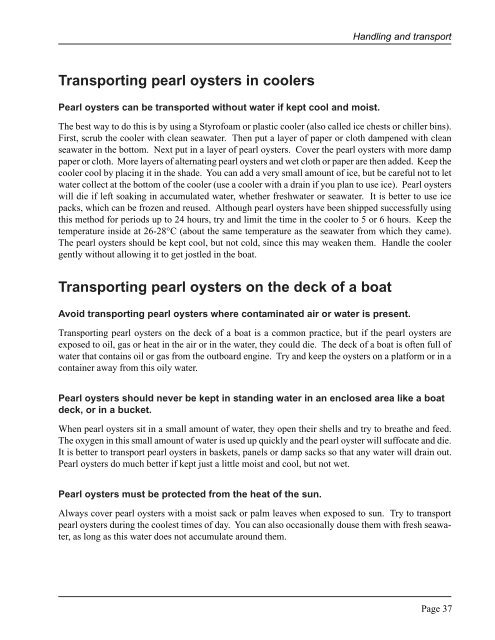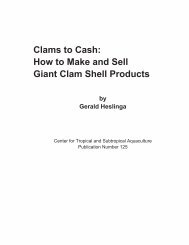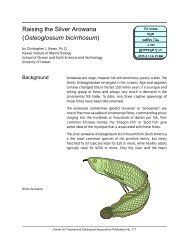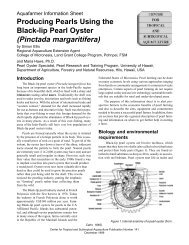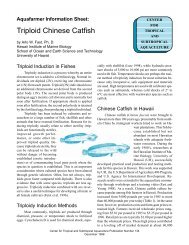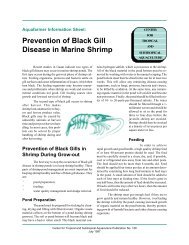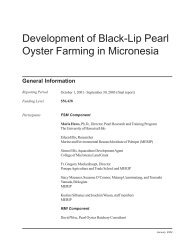The Basic Methods of Pearl Farming: A Layman's Manual - CTSA
The Basic Methods of Pearl Farming: A Layman's Manual - CTSA
The Basic Methods of Pearl Farming: A Layman's Manual - CTSA
Create successful ePaper yourself
Turn your PDF publications into a flip-book with our unique Google optimized e-Paper software.
Handling and transportTransporting pearl oysters in coolers<strong>Pearl</strong> oysters can be transported without water if kept cool and moist.<strong>The</strong> best way to do this is by using a Styr<strong>of</strong>oam or plastic cooler (also called ice chests or chiller bins).First, scrub the cooler with clean seawater. <strong>The</strong>n put a layer <strong>of</strong> paper or cloth dampened with cleanseawater in the bottom. Next put in a layer <strong>of</strong> pearl oysters. Cover the pearl oysters with more damppaper or cloth. More layers <strong>of</strong> alternating pearl oysters and wet cloth or paper are then added. Keep thecooler cool by placing it in the shade. You can add a very small amount <strong>of</strong> ice, but be careful not to letwater collect at the bottom <strong>of</strong> the cooler (use a cooler with a drain if you plan to use ice). <strong>Pearl</strong> oysterswill die if left soaking in accumulated water, whether freshwater or seawater. It is better to use icepacks, which can be frozen and reused. Although pearl oysters have been shipped successfully usingthis method for periods up to 24 hours, try and limit the time in the cooler to 5 or 6 hours. Keep thetemperature inside at 26-28°C (about the same temperature as the seawater from which they came).<strong>The</strong> pearl oysters should be kept cool, but not cold, since this may weaken them. Handle the coolergently without allowing it to get jostled in the boat.Transporting pearl oysters on the deck <strong>of</strong> a boatAvoid transporting pearl oysters where contaminated air or water is present.Transporting pearl oysters on the deck <strong>of</strong> a boat is a common practice, but if the pearl oysters areexposed to oil, gas or heat in the air or in the water, they could die. <strong>The</strong> deck <strong>of</strong> a boat is <strong>of</strong>ten full <strong>of</strong>water that contains oil or gas from the outboard engine. Try and keep the oysters on a platform or in acontainer away from this oily water.<strong>Pearl</strong> oysters should never be kept in standing water in an enclosed area like a boatdeck, or in a bucket.When pearl oysters sit in a small amount <strong>of</strong> water, they open their shells and try to breathe and feed.<strong>The</strong> oxygen in this small amount <strong>of</strong> water is used up quickly and the pearl oyster will suffocate and die.It is better to transport pearl oysters in baskets, panels or damp sacks so that any water will drain out.<strong>Pearl</strong> oysters do much better if kept just a little moist and cool, but not wet.<strong>Pearl</strong> oysters must be protected from the heat <strong>of</strong> the sun.Always cover pearl oysters with a moist sack or palm leaves when exposed to sun. Try to transportpearl oysters during the coolest times <strong>of</strong> day. You can also occasionally douse them with fresh seawater,as long as this water does not accumulate around them.Page 37


